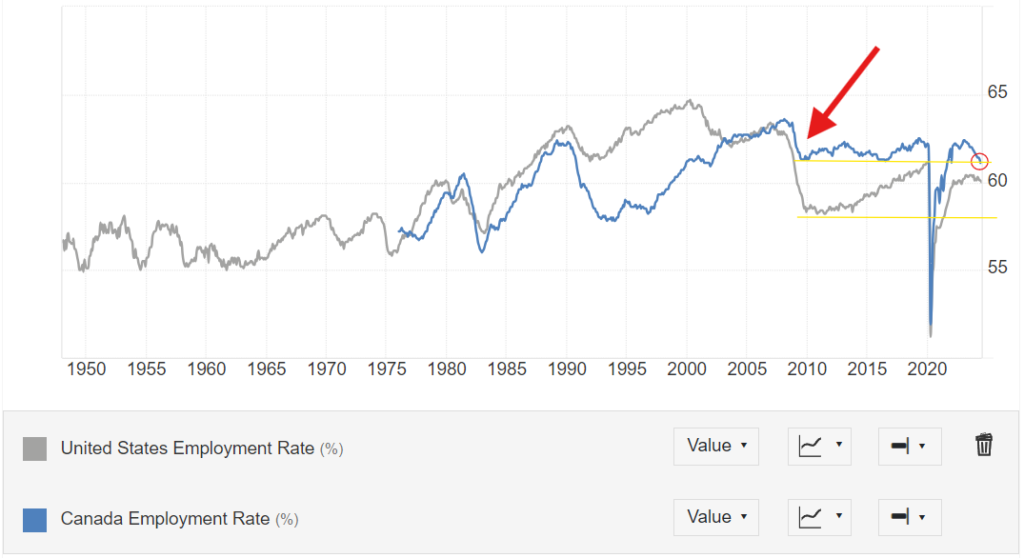Canada’s Total Employment Rate Lower Than During Great Recession
As of June 2024, the employment rate in Canada stands at 61.10 percent, marking a slight decrease from 61.30 percent in May 2024. According to Statistics Canada, “Employment Rate in Canada decreased to 61.10 percent in June from 61.30 percent in May of 2024. Employment Rate in Canada averaged 60.45 percent from 1976 until 2024, reaching an all time high of 63.60 percent in February of 2008 and a record low of 51.90 percent in April of 2020.” https://www.statcan.gc.ca/
The current employment rate is particularly concerning as it is now lower than the 61.3 percent recorded during the worst period of the 2008-09 financial crisis. This decline raises questions about the resilience of Canada’s labor market in the face of economic uncertainties, especially in comparison to historical benchmarks.
Comparing Canada to the U.S.
While Canada’s employment rate is struggling to maintain pre-pandemic levels, the situation in the United States presents a different narrative. The U.S. total employment rate has recovered significantly from the lows of the Great Recession and is currently much higher than it was during that period. However, it still remains below the pre-COVID levels, indicating that both North American economies are grappling with post-pandemic challenges in their labor markets.
Employment Rate Trends: Canada vs. U.S.

This graph illustrates the employment rate trends in Canada and the United States over the past few years, highlighting the distinct recovery trajectories in both countries. The comparison sheds light on the underlying factors influencing employment dynamics in these two closely linked economies.
Factors Contributing to the Decline
Several factors could be contributing to the current decline in Canada’s employment rate. The post-pandemic economic recovery has been uneven across different sectors, with some industries still struggling to return to pre-pandemic levels of activity. Additionally, rising interest rates and inflationary pressures have likely played a role in dampening job growth, particularly in sectors sensitive to consumer spending.
The decline in employment also raises concerns about potential structural changes in the labor market. As businesses adapt to new economic realities, shifts in demand for certain skills and occupations could be leaving some workers behind. This transition period may be contributing to the sluggish recovery in employment rates, especially when compared to historical standards.
Looking Ahead
Canada’s labor market faces a challenging road ahead. Policymakers will need to address the underlying issues contributing to the decline in employment and ensure that the economy can support a more robust and inclusive job market. This will likely require a combination of targeted fiscal policies, investment in skills training, and measures to stimulate job creation in sectors with growth potential.
The ongoing monitoring of employment trends will be crucial in assessing the effectiveness of these policies and in guiding future actions. As the global economy continues to evolve, Canada’s ability to adapt and recover will be key to restoring its employment rate to more stable and sustainable levels.


